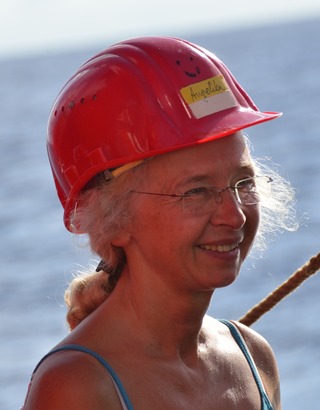
An abyssal plain is an underwater plain on the deep ocean floor, usually found at depths between 3,000 and 6,000 metres. Lying generally between the foot of a continental rise and a mid-ocean ridge, abyssal plains cover more than 50% of the Earth's surface. They are among the flattest, smoothest, and least explored regions on Earth. Abyssal plains are key geologic elements of oceanic basins.

Kiwa hirsuta is a crustacean discovered in 2005 in the South Pacific Ocean. This decapod, which is approximately 15 cm (5.9 in) long, is notable for the quantity of silky blond setae covering its pereiopods. Its discoverers dubbed it the "yeti lobster" or "yeti crab".

Kiwa is a genus of marine decapods living at deep-sea hydrothermal vents and cold seeps. The animals are commonly referred to as "yeti lobsters" or "yeti crabs”, after the legendary yeti, because of their "hairy" or bristly appearance. The genus is placed in its own family, Kiwaidae, in the superfamily Chirostyloidea. The genus Kiwa is named after the god of shellfish in Polynesian mythology.

Chondrocladia is a genus of carnivorous demosponges of the family Cladorhizidae. Neocladia was long considered a junior synonym, but recently become accepted as a distinct genus.

Chrysomallon squamiferum, commonly known as the scaly-foot gastropod, scaly-foot snail, sea pangolin, or volcano snail is a species of deep-sea hydrothermal-vent snail, a marine gastropod mollusc in the family Peltospiridae. This vent-endemic gastropod is known only from deep-sea hydrothermal vents in the Indian Ocean, where it has been found at depths of about 2,400–2,900 m (1.5–1.8 mi). C. squamiferum differs greatly from other deep-sea gastropods, even the closely related neomphalines. In 2019, it was declared endangered on the IUCN Red List, the first species to be listed as such due to risks from deep-sea mining of its vent habitat.

Pleurotomella deliciosa is a species of sea snail, a marine gastropod mollusk in the family Raphitomidae.
Typhlodaphne strebeli is a species of sea snail, a marine gastropod mollusk in the family Borsoniidae.
Admete haini is a species of sea snail, a marine gastropod mollusk in the family Cancellariidae, the nutmeg snails.

Limacina rangii is a species of swimming sea snail in the family Limacinidae, which belong to the group commonly known as sea butterflies (Thecosomata).

Gigantopelta chessoia is a species of deep sea snail from hydrothermal vents, a marine gastropod mollusk in the family Peltospiridae.

Lepetodrilus sp. East Scotia Ridge is an as yet undescribed species of small, deep-sea sea snail, a hydrothermal vent limpet, a marine gastropod mollusk in the family Lepetodrilidae.

Kiwa tyleri, the Hoff crab, is a species of deep-sea squat lobster in the family Kiwaidae, which lives on hydrothermal vents near Antarctica. The crustacean was given its English nickname in 2010 by UK deep-sea scientists aboard the RRS James Cook, owing to resemblance between its dense covering of setae on the ventral surface of the exoskeleton and the hairy chest of the actor David Hasselhoff. The 2010 expedition to explore hydrothermal vents on the East Scotia Ridge was the second of three expeditions to the Southern Ocean by the UK led research consortium, ChEsSo.

Angelika Brandt is the world leader in Antarctic deep-sea biodiversity and has developed, organised and led several oceanographic expeditions to Antarctica, notably the series of ANDEEP cruises, which have contributed significantly to Antarctica and deep-sea biology. Brandt was the senior scientist of ANDEEP which was devoted entirely to benthic research in the Antarctic abyss.

Gigantopelta aegis is a species of deep sea snail from hydrothermal vents, a marine gastropod mollusc in the family Peltospiridae.

Jan Maree Strugnell is an Australian evolutionary molecular biologist. She is a professor and director in the Centre for Sustainable Tropical Fisheries and Aquaculture at James Cook University, Townsville, Australia. Strugnell's work has investigated population and species level molecular evolution in Antarctic and deep sea species in the context of past geological and climatic change. Strugnell's work also uses genetic tools to help solve bottlenecks in aquaculture and fisheries industries.
Neolithodes yaldwyni is a species of king crab which is found in the Ross Sea from depths of 124–1,950 metres (407–6,398 ft). It had previously been misidentified as Neolithodes brodiei, and it closely resembles Neolithodes capensis.
Neolithodes capensis is a species of king crab which is found in the Southern Ocean and the western Indian Ocean. It has been found to a depth of 660–3,200 metres (2,170–10,500 ft).

Neolithodes diomedeae is a species of king crab which is found in the eastern Pacific Ocean, the southwestern Atlantic Ocean, and the Bellingshausen and Scotia Seas in the Southern Ocean. They occur from 200 to 2,454 m.
Kemp Caldera and Kemp Seamount form a submarine volcano south of the South Sandwich Islands, in a region where several seamounts are located. The seamount rises to a depth of 80 metres (260 ft) below sea level; the caldera has a diameter of 8.3 by 6.5 kilometres and reaches a depth of 1,600 metres (5,200 ft). The caldera contains several Hydrothermal vents, including white smokers and diffuse venting areas, which are host to chemolithotrophic ecological communities. The seamount and caldera, which were discovered by seafloor mapping in 2009, are part of the South Georgia and the South Sandwich Islands Marine Protected Area.













